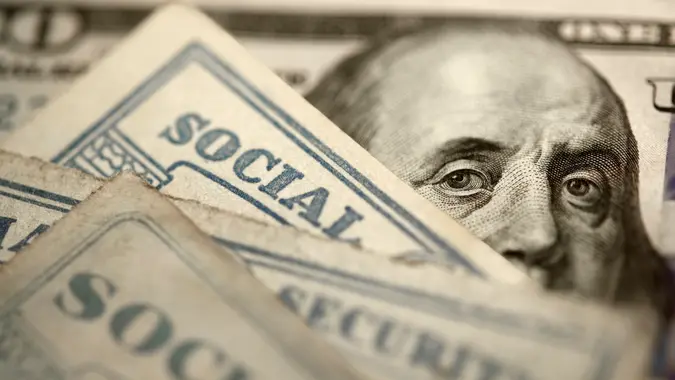5 Frugal Ways Women Can Boost Their Retirement Savings in 2025

Commitment to Our Readers
GOBankingRates' editorial team is committed to bringing you unbiased reviews and information. We use data-driven methodologies to evaluate financial products and services - our reviews and ratings are not influenced by advertisers. You can read more about our editorial guidelines and our products and services review methodology.

20 Years
Helping You Live Richer

Reviewed
by Experts

Trusted by
Millions of Readers
Saving money is always difficult when you are living paycheck to paycheck. This becomes even more evident when you are making less than your coworkers.
With frugal living being directly correlated to the rising cost of living, everyone is looking for ways to stretch their dollars. Though this is true for the average American, it holds a special sense of urgency for American women.
Women still earn, on average, 16% less than men, and that percentage is even worse for women of color. This harsh reality comes into even starker relief when retirement is around the corner, and some women’s bank accounts aren’t as robust as they’d be in an ideal world.
But fear not! Experts at Fidelity addressed how women can ramp up their retirement planning with quick and easy tips to start saving in a recent Women Talk Money newsletter. The newsletter dives into all the ways frugal women can start getting their finances in order — for retirement and beyond.
Here are five ways for women to up their savings before retirement, according to the experts.
Check If You’re on Track To Retire Rich
Before you can cash in those Social Security checks, you may need to assess how your retirement savings are stacking up against your retirement timeline. According to Fidelity, the first step in ramping up your retirement savings is to assess your current situation and determine if you’re on track to meet your financial goals.
Fidelity recommends using their Retirement Score tool to get a real picture of how ready you truly are based on your age, income and existing savings. Their website states that the tool “can show you how adjustments to monthly savings, investment style and other factors could impact your preparedness.”
If the numbers aren’t cutting it, that’s your cue to go into overdrive. It may be time to put down the credit card and start an emergency fund or look into investing in other 401(k) or IRA options.
Take Advantage of Catch-Up Contributions
If you’re approaching retirement age, maybe you’ve found that you have less money saved for retirement than you need. Fortunately, the IRS recognizes this challenge. If you’re 50 or older, it offers what are known as catch-up provisions. These special provisions let you contribute additional funds to your retirement accounts.
In 2024, the catch-up contribution limit for 401(k) and 403(b) plans was $7,500. This is on top of the standard contribution limit of $22,500. However, now in 2025, employees can defer $23,500 into 401(k) plans, plus a catch-up contribution of $7,500 for investors age 50 and older. The catch-up contribution also rises to $11,250 for savers age 60 to 63 this year.
For IRAs, 2025 also has a higher catch-up contribution limit of $11,250 instead of $7,500. The income ranges for determining eligibility to make deductible contributions to IRAs or to contribute to Roth IRAs all increased for 2025.
This is a great way to give your retirement savings a much-needed boost, helping you make up for lost time.
Master Tax-Advantaged Account Hacks
If you want to keep more of your own money, then you need to get strategic with accounts that offer excellent tax advantages, like 401(k)s, IRAs and HSAs.
The Fidelity newsletter shared this genius HSA hack: “You may want to consider paying for current-year qualified medical expenses out of pocket and letting your HSA contributions remain invested in your HSA. That way, the money has the potential to grow tax-free and be used to pay for future qualified medical expenses, including those in retirement.”
Get That Money Working Smarter
Simply saving cash, though a good start, often isn’t enough to accrue the ever-increasing nest egg financial advisors say you should have before you retire. You need to invest it wisely for maximum growth.
However, the newsletter advises slowly decreasing stock exposure as you age while maintaining a diversified portfolio across investment types: “Whatever your projected retirement date, your goal should be to have a portfolio with exposure to various types of investments that can provide the opportunity for growth and the potential to outpace inflation, along with investments that offer some degree of risk-reducing diversification.”
Index funds and ETFs are smart bets for keeping fees low. If this is too much for your risk tolerance, it also helps to fund high-yield savings products to make sure your money is growing as quickly as possible.
Define Your Dream Retirement Vision
Building wealth is only half the battle. You need to decide how you actually want to spend those sunny retirement years. Maybe you dream of traveling the world, pursuing hobbies or spending quality time with your family. Having that crystal clear vision will keep frugal women motivated to sacrifice and save now for the payoff later.
Laura Beck contributed to the reporting for this article.
More From GOBankingRates
 Written by
Written by  Edited by
Edited by 

























